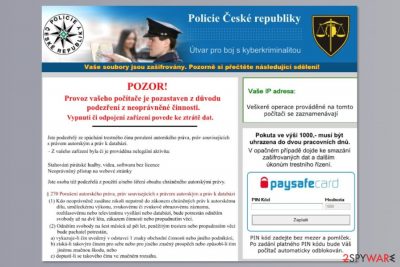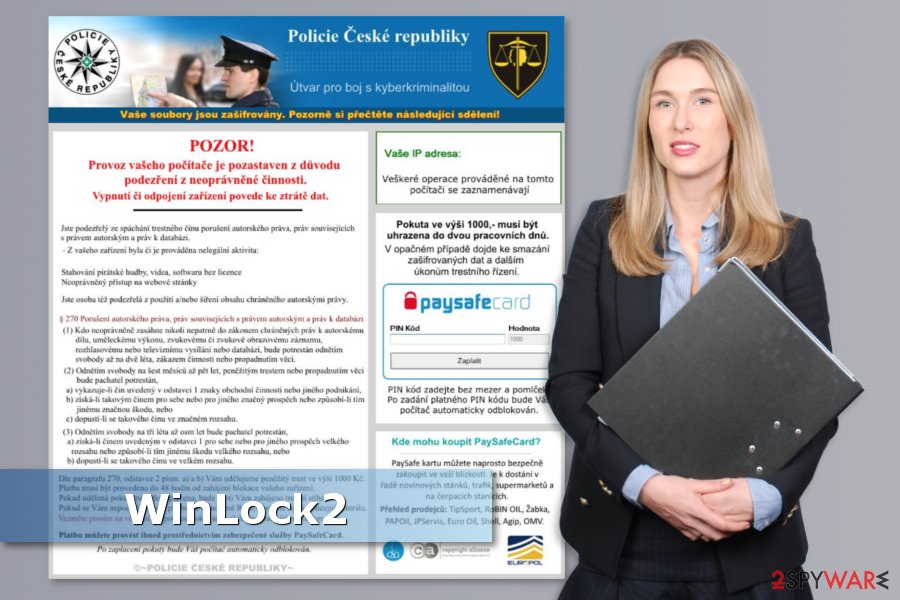WinLock2 ransomware (Free Guide) - Virus Removal Instructions
WinLock2 virus Removal Guide
What is WinLock2 ransomware?
Authors of WinLock2 target Czech-speaking Call of Duty WWII players

WinLock2 is a ransomware virus that has features of the screenlocker. Researchers have noticed it spreading as a fake Call of Duty WWII game and targeting Czech computer users. The scam tells that victims broke the law and now have to pay 1000 Czech koruna to get back encrypted files.
The lock screen message delivered by the WinLock2 ransomware has an excerpt from the legal documents that talk about possible penalties for breaking the law. Scammers want to make victims believe that they are accused of:
- downloading music or videos illegally;
- using cracked software;
- visited forbidden websites.
Authors of WinLock2 virus threaten to delete all the data if people don’t pay the ransom. Victims are asked to pay 1000 Check koruna in order to get a PIN code that unlocks the screen. Once criminals receive the money, they should provide a code that victims are supposed to enter into the provided form.
However, security specialists do not recommend doing this. Criminals may never give you a code or might blackmail you into paying more money. Therefore, you should bypass the lock screen and remove WinLock2 from the computer as soon as possible.
However, the scam might look credible for inexperienced computer users. It uses the clean design, Czech police credentials, and logos of other organizations, such as Europol. However, you should never forget that legal institutions do not lock computer’s screen, as well as do not demand to pay the ransom in order to avoid punishment.
If your computer was hacked by this malware, you should immediately run WinLock2 removal with FortectIntego or another malware removal program. However, if you have problems with the elimination, you should check the guide below.

Malware spreads as Call of Duty WWII crack
The ransomware that targets Czech computer users spread as a crack for a popular game – Call of Duty WWII. The name of the malicious file – Call_of_Duty_WWII_SKIDROWcracked.exe. Once it is dropped on the system, it is executed and launches ransomware on the device.
Additionally, researchers found another sample of malware that spreads as an obfuscated WinLock2.exe file. This file might be spread using other methods, such as:
- malicious spam emails,
- other illegal games or software downloads,
- fake software updates,
- malware-laden ads.
Detailed guide on how to get rid of WinLock2 ransomware virus
The virus operates as a screenlocker and ransomware. Thus, you have to unlock computer’s screen in order to remove WinLock2 entirely. Follow these steps:
- Enter the PIN of the 16 random characters, for instance, “0123456789abcdefand” and click the button called “Zaplatt.”
- You will receive a prompt window saying:
Platba proběhla úspěšně! Počítač bude odblokován. - Click OK.
- You will see another prompt that tells to reboot your computer which you should ignore:
Nyní restartujte svůj počítač.
However, instead of rebooting the computer, you have to run FortectIntego, Malwarebytes or another anti-malware software to delete WinLock2 from the computer. Do not try to locate and eliminate malicious components manually. It’s a complicated cyber threat that may have affected critical system processes. Thus, you do not want to damage them.
However, if you cannot run security software, you may need to restart your PC in Safe Mode with Networking as shown below. This should help to perform the automatic WinLock2 removal.
Getting rid of WinLock2 virus. Follow these steps
Manual removal using Safe Mode
Follow these steps to reboot the system to Safe Mode with Networking to disable the virus and run automatic elimination:
Important! →
Manual removal guide might be too complicated for regular computer users. It requires advanced IT knowledge to be performed correctly (if vital system files are removed or damaged, it might result in full Windows compromise), and it also might take hours to complete. Therefore, we highly advise using the automatic method provided above instead.
Step 1. Access Safe Mode with Networking
Manual malware removal should be best performed in the Safe Mode environment.
Windows 7 / Vista / XP
- Click Start > Shutdown > Restart > OK.
- When your computer becomes active, start pressing F8 button (if that does not work, try F2, F12, Del, etc. – it all depends on your motherboard model) multiple times until you see the Advanced Boot Options window.
- Select Safe Mode with Networking from the list.

Windows 10 / Windows 8
- Right-click on Start button and select Settings.

- Scroll down to pick Update & Security.

- On the left side of the window, pick Recovery.
- Now scroll down to find Advanced Startup section.
- Click Restart now.

- Select Troubleshoot.

- Go to Advanced options.

- Select Startup Settings.

- Press Restart.
- Now press 5 or click 5) Enable Safe Mode with Networking.

Step 2. Shut down suspicious processes
Windows Task Manager is a useful tool that shows all the processes running in the background. If malware is running a process, you need to shut it down:
- Press Ctrl + Shift + Esc on your keyboard to open Windows Task Manager.
- Click on More details.

- Scroll down to Background processes section, and look for anything suspicious.
- Right-click and select Open file location.

- Go back to the process, right-click and pick End Task.

- Delete the contents of the malicious folder.
Step 3. Check program Startup
- Press Ctrl + Shift + Esc on your keyboard to open Windows Task Manager.
- Go to Startup tab.
- Right-click on the suspicious program and pick Disable.

Step 4. Delete virus files
Malware-related files can be found in various places within your computer. Here are instructions that could help you find them:
- Type in Disk Cleanup in Windows search and press Enter.

- Select the drive you want to clean (C: is your main drive by default and is likely to be the one that has malicious files in).
- Scroll through the Files to delete list and select the following:
Temporary Internet Files
Downloads
Recycle Bin
Temporary files - Pick Clean up system files.

- You can also look for other malicious files hidden in the following folders (type these entries in Windows Search and press Enter):
%AppData%
%LocalAppData%
%ProgramData%
%WinDir%
After you are finished, reboot the PC in normal mode.
Remove WinLock2 using System Restore
-
Step 1: Reboot your computer to Safe Mode with Command Prompt
Windows 7 / Vista / XP- Click Start → Shutdown → Restart → OK.
- When your computer becomes active, start pressing F8 multiple times until you see the Advanced Boot Options window.
-
Select Command Prompt from the list

Windows 10 / Windows 8- Press the Power button at the Windows login screen. Now press and hold Shift, which is on your keyboard, and click Restart..
- Now select Troubleshoot → Advanced options → Startup Settings and finally press Restart.
-
Once your computer becomes active, select Enable Safe Mode with Command Prompt in Startup Settings window.

-
Step 2: Restore your system files and settings
-
Once the Command Prompt window shows up, enter cd restore and click Enter.

-
Now type rstrui.exe and press Enter again..

-
When a new window shows up, click Next and select your restore point that is prior the infiltration of WinLock2. After doing that, click Next.


-
Now click Yes to start system restore.

-
Once the Command Prompt window shows up, enter cd restore and click Enter.
Bonus: Recover your data
Guide which is presented above is supposed to help you remove WinLock2 from your computer. To recover your encrypted files, we recommend using a detailed guide prepared by 2-spyware.com security experts.If malware encrypts or corrupts some of the files and you do not have backups, you should try alternative recovery methods.
If your files are encrypted by WinLock2, you can use several methods to restore them:
Data Recovery Pro – alternative tool to restore data
Originally, this program is designed to restore corrupted or accidentally deleted files. However, it might help to recover encrypted files as well.
- Download Data Recovery Pro;
- Follow the steps of Data Recovery Setup and install the program on your computer;
- Launch it and scan your computer for files encrypted by WinLock2 ransomware;
- Restore them.
Try Windows Previous Versions feature
If System Restore was enabled before WinLock2 ransomware attack, you can follow these steps and copy individual files:
- Find an encrypted file you need to restore and right-click on it;
- Select “Properties” and go to “Previous versions” tab;
- Here, check each of available copies of the file in “Folder versions”. You should select the version you want to recover and click “Restore”.
Use ShadowExplorer
If malware did not delete Shadow Volume Copies, this tool can be helpful in data recovery as well.
- Download Shadow Explorer (http://shadowexplorer.com/);
- Follow a Shadow Explorer Setup Wizard and install this application on your computer;
- Launch the program and go through the drop down menu on the top left corner to select the disk of your encrypted data. Check what folders are there;
- Right-click on the folder you want to restore and select “Export”. You can also select where you want it to be stored.
Finally, you should always think about the protection of crypto-ransomwares. In order to protect your computer from WinLock2 and other ransomwares, use a reputable anti-spyware, such as FortectIntego, SpyHunter 5Combo Cleaner or Malwarebytes
How to prevent from getting ransomware
Stream videos without limitations, no matter where you are
There are multiple parties that could find out almost anything about you by checking your online activity. While this is highly unlikely, advertisers and tech companies are constantly tracking you online. The first step to privacy should be a secure browser that focuses on tracker reduction to a minimum.
Even if you employ a secure browser, you will not be able to access websites that are restricted due to local government laws or other reasons. In other words, you may not be able to stream Disney+ or US-based Netflix in some countries. To bypass these restrictions, you can employ a powerful Private Internet Access VPN, which provides dedicated servers for torrenting and streaming, not slowing you down in the process.
Data backups are important – recover your lost files
Ransomware is one of the biggest threats to personal data. Once it is executed on a machine, it launches a sophisticated encryption algorithm that locks all your files, although it does not destroy them. The most common misconception is that anti-malware software can return files to their previous states. This is not true, however, and data remains locked after the malicious payload is deleted.
While regular data backups are the only secure method to recover your files after a ransomware attack, tools such as Data Recovery Pro can also be effective and restore at least some of your lost data.





















